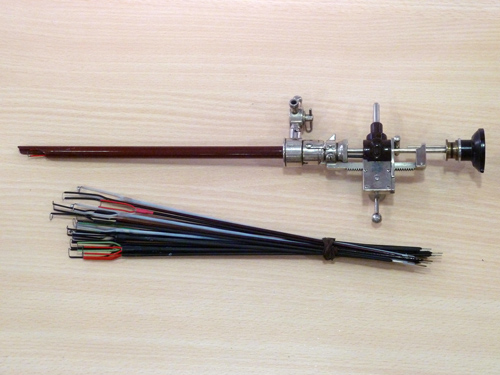Stern-McCarthy Resectoscope
Rack-and-pinion mechanism
The first resectoscope was introduced by Maximilian Stern (1843 – 1946) in 1926 in the USA. This innovative instrument allowed Stern to cut slivers of prostate, under direct vision, using a tungsten wire loop, through which flowed an undamped electrical cutting current. This radiofrequency current had been developed by the Western Electric Company. Unfortunately, the current cut well but did not coagulate deeply enough, leading one commentator to say, “one may as well be using a knife”.
In 1931, Theodore Davis (1889 – 1973), a South Carolina urologist with a background in electrical engineering, presented a modified resectoscope. He used a larger instrument with a larger viewing window and a wider loop. More importantly he incorporated both cutting and coagulation current diathermy, inventing a foot pedal allowing him to switch between the two during surgery.
In the same year, Joseph McCarthy (1874 – 1965) combined his excellent panendoscope (a foreoblique lens system invented by Frederick Wappler), which had improved vision, Davis's dual current idea and Stern's resectoscope. He encased it in a Bakelite sheath, as used by Kenneth Walker of London in an earlier punch. Thus, McCarthy created a more practical and usable instrument. The Stern-McCarthy resectoscope soon became the choice of urologists internationally for many years.
The instrument pictured above is a resectoscope (circa 1932) with a rack-and-pinion working mechanism from the Addenbrooke's collection.


McCarthy resectoscope from the Derby Collection

A rather unusual McCarthy resectoscope with an ebony handle, probably a customised model.

A nice boxed McCarthy resectoscope from the Morris Donation.
← Back to Resectoscopes